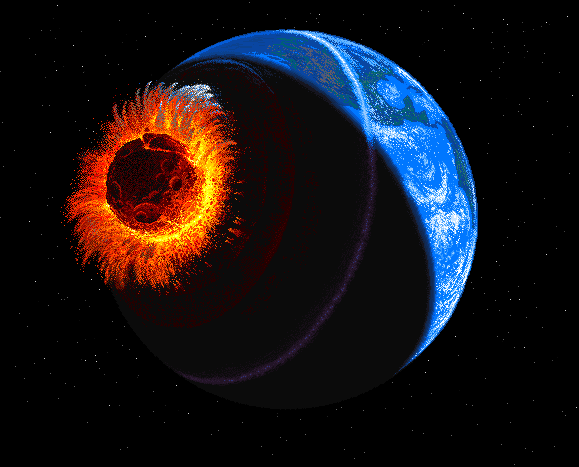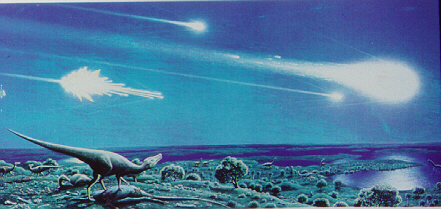
What Killed The Dinosaurs?
Current Arguments

Current Arguments
The major sides of the schism can be broken down (greatly simplifying the issue, but making it more accessible) into "intrinsic gradualists" and "extrinsic catastrophists". We'll describe each generalized group in turn, and then try to synthesize the available information so you can form your own opinion. But first, let's outline what scientists generally agree that we know about the K-T boundary:
3. As discussed before, many organisms; both marine and terrestrial, vertebrate and invertebrate; went extinct. The reason for this extinction was probably this climate change.
Note that these two above hypotheses are inextricably tied together; volcanism cannot occur without the action of plate tectonics, and vice versa. If the extinction was intrinsic and gradual, both processes probably played a role. Also note that the basic theory here is an elaboration of the 'dinosaurs faded away' hypothesis from the invalid hypotheses section; it adds a factor of causation that is quite convincing.

The Alvarez Hypothesis: The original hypothesis is the basis for several subsequent variations on the theme that a large extraterrestrial object collided with the Earth, its impact throwing up enough dust to cause the climatic change. The iridium layer is what prompted the Alvarez team to blame an asteroid impact for the extinction -- asteroids and similar extraterrestrial bodies are higher in iridium content than the Earth's crust, so they figured that the iridium layer must be composed of the dust from the vaporized meteor. No crater was found, but it was assumed that one existed that was about 65 million years old and 100 kilometers (about 65 miles) in diameter.
Later research found a likely candidate for the crater at Chicxulub, on the Yucatan Peninsula of Mexico. Other evidence was also reported: the presence of shocked quartz in the rocks of the K-T boundary (indicating a violent tremor that cracked the quartz grains), glassy spheres that looked like impact ejecta (molten rock that solidified into droplets when cooled), and a soot layer was found in many areas (evidence for widespread forest fires). The likelihood that massive hurricanes and firestorms would have raged across the Earth was also hypothesized, adding to the destructive power of the catastrophe.
To reconcile the hypothesis with gradual data, it was suggested that rather than one impact, several impacts (of comets or meteors) could have occurred over a period of many years. Some evidence supported this -- a hint of periodicity of mass extinctions in the fossil record was reported; mass extinctions seemed to occur roughly every 26 million years. Astronomers theorized that the Oort cloud of comets could cross the path of our solar system every 26 million years, and would possibly rain comets on our planet for a few million years. The existence of a tenth, as-yet unseen planet -- or Nemesis, the twin star to our sun -- both with large orbits were also contemplated. To date, no reliable evidence for periodicity or Nemesis-type celestial bodies has been found, but this does not render the hypothesis obsolete; it is accepted that any large extraterrestrial body impacting the Earth's surface could and would produce climatic changes similar to those thought to have occurred around the K-T boundary.

All of this work was not without its detractors, of course; we'll discuss that in the final section.
All of the evidence cited for the extrinsic catastrophist side is claimed as evidence by the intrinsic gradualists for their side or against the opposite side- volcanoes could create the iridium layer, shocked quartz, soot, and impact ejecta; the makeup of the iridium layer is not uniform in all areas, so it could be meaningless; and so on.
The main problem with both hypotheses is the issue of the selectivity of the mass extinction; as you saw before in the background section, some organisms were wiped out, while others were unaffected. Can climate change really explain the differential selectivity of the K-T event? Our lack of understanding of the physiology of dinosaurs makes the issue more complex; if they were endothermic, why did they not survive like birds and mammals? If they were ectothermic, why did small dinosaurs not survive like small reptiles?
Also, many studies have focused on the extinction of dinosaurs alone, and have forgotten about the more substantial marine ecosystem collapse. The fossil record suggests that some marine reptiles died out several million years prior to the K-T boundary.
Other major problems with the issue are that it is not easy to prove (test) causation (as noted before), and that most of the ages of the rocks that different evidence comes from are questionable. It is not certain whether there is a gradual decline in the global fossil record, or if there was a sudden catastrophe; some studies in some areas show evidence pointing to different answers.
Ultimately, we just don't know yet for sure. The two main schools of thought are split fairly evenly among scientists familiar with them. Either an intrinsic or extrinsic cause for the extinction would have complex biotic effects on ecosystems which would look confusing in the fossil record. There could well have been different, even separate extinctions in the oceans and on land; the marine fossil record does support a slightly rapid decline, while the terrestrial record (especially in North America) strongly suggests a more gradual decline (but again, has a fragmentary fossil record). If an extraterrestrial impact occurred during a gradual decline, that might explain the seemingly contradictory evidence. If you are looking for an opinion here from a paleontologist's point of view, it seems that the simplest explanation is that the climatic changes induced by the shifting continents and the regression of the continental seaways were the ultimate cause (at least in North America), but this has not been (and may not ever be) proven. There is much work to be done, and much value to this work -- understanding the K-T extinction would help us to understand mass extinctions in general, and might provide a glimpse into the fleeting, evanescent nature of our own mortality.
Return to the DinoBuzz |